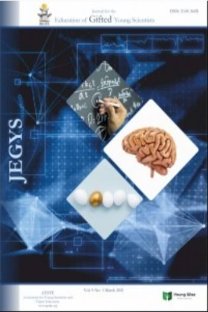Construction of The Assessment Concept to Measure Students' High Order Thinking Skills
This study aims to develop a question instrument that able to measure students' high order thinking skills. The sample used in this study involved 3 expert validators, 2 user practitioners, 60 students in the limited test and 125 students in the field test. Data results were analyzed using the Quest program. The results of the study show that the characteristics of the assessment of high order thinking ability of students have validity with a "sufficient" minimum interpretation and have sufficient reliability. Validity with minimum interpretation is adequate, reliability is good, level of difficulty of questions with proportion of 1.6% is easy, 58.4% is moderate and 40% is difficult for multiple choice questions and 0% is easy, 50% is moderate and 50% is difficult for essay questions. The profile of the product score assessment to measure students' high order thinking skills is as follows: State High School B with a high order thinking skills scores reached 71.61, then continued with State High School D with a score of 66.03, State High School C with a score of 65.46, State High School E with a score of 63.69, and the last one is State High School A with a score of 60.26. Overall with the number of students 125 people have an average score of 65.41. So the high school that have a highest score is State High School B in profile assessment.
Keywords:
Higher Order Thinking Skills, Assessment, Reproductive System, Senior High School Biology,
___
- Anderson, L. W., Krathwohl, D. R., Airasian, P. W., Cruikshank, K. A., Mayer, R. E., Pintrich, P. R., … Wittrock, M. C. (2001). A taxonomy for learning, teaching, and assessing: A revision of Bloom’s taxonomy of educational objectives, abridged edition. New York: Longman.
- Arikunto, S. (1997). Penilaian Program Pendidikan (3rd ed.). Jakarta: Bina Aksara.
- Arikunto, S. (2006). Prosedur Penelitian Suatu Pendekatan Praktik. Jakarta: Rineka Cipta.
- Borg, W. R., & Gall, M. D. (1983). Education Research: An Introducation. New York & London: Longman Inc.
- Cullinane, A., & Liston, M. (2011). Two-tier Multiple Choice Question: An Alternative Method of Formatif Assessment for First Year Undergraduate Biology Students. Linmark: National Center for Excellence In Mathematics and Education Science Teaching and Learning (NCE-MSTL).
- Group, A. R. (2002). Assessment for learning: Beyond the black box. Cambridge: University of Cambridge School of Education.Indonesia, P. M. P. dan K. R. (2013). Nomor 81a Implementasi Kurikulum 2013 (No. 81a). Jakarta, Indonesia.
- Juita, R. (2019). Meningkatkan Hasil Belajar IPA Melalui Metode Eksperimen Pada Siswa Kelas IV SDN 02 Kota Mukomuko. IJIS Edu : Indonesian Journal of Integrated Science Education, 1(1), 43–50. Retrieved from http://ejournal.iainbengkulu.ac.id/index.php/ijisedu
- Julaila. (2019). Upaya Meningkatkan Hasil Belajar IPA Siswa Kelas IV SDN 01 Mukomuko Menggunakan Media Torso. IJIS Edu : Indonesian Journal of Integrated Science Education, 1(1), 51–62. Retrieved from http://ejournal.iainbengkulu.ac.id/index.php/ijisedu
- Kartimi, K., & Liliasari, L. (2012). PENGEMBANGAN ALAT UKUR BERPIKIR KRITIS PADA KONSEP TERMOKIMIA UNTUK SISWA SMA PERINGKAT ATAS DAN MENENGAH. Jurnal Pendidikan IPA Indonesia, 1(1), 21–26. https://doi.org/10.15294/jpii.v1i1.2008
- Kay, K. (2009). Middle schools preparing young people for 21st century life and work. Middle School Journal, 40(5), 41–45. https://doi.org/https://doi.org/10.1080/00940771.2009.11461691
- Kusumah, R. G. T., & Munandar, A. (2017). ANALYSIS OF THE RELATIONSHIP BETWEEN SELF EFFICACY AND HEALTHY LIVING CONCIOUSNESS TOWARD SCIENCE LEARNING OUTCOME. EDUSAINS, 9(2). https://doi.org/10.15408/ES.V9I2.2183
- Leward, B. C., & Hirata, D. (2011). An Overview of 21st Century Skills. Honolulu: Kamehameha Schools-Research & Evaluation.
- Lewis, A., & Smith, D. (1993). Defining higher order thinking. Theory Into Practice, 32(3), 131–137. https://doi.org/https://doi.org/10.1080/00405849309543588Linn, R. L., & Gronlund, N. (n.d.). E.(1995). Measurment and Assessment in Teaching, 7.Ministry of Education and Culture. (2011). Survey International PISA. Online. Jakarta.
- Peter, E. E. (2012). Critical thinking: Essence for teaching mathematics and mathematics problem solving skills. African Journal of Mathematics and Computer Science Research, 5(3), 39–43. https://doi.org/https://doi.org/10.5897/AJMCSR11.161Putra, B. K. B., Prayitno, B. A., & Maridi, M. (2018). The Effectiveness of Guided Inquiry and INSTAD towards Students’ Critical Thinking Skills on Circulatory System Materials. Jurnal Pendidikan IPA Indonesia, 7(4), 476–482. https://doi.org/10.15294/jpii.v7i4.14302
- Rasch, G. (1980). Probabilistic Models for Some Intelligence and Attainment Tests. Chicago: University of Chicago.Sajidan, Sugiharto, B., & Prasetyani, N. M. (2013). Penerapan Model Pengembangan Mutu Pendidikan Dalam Rangka Peningkatan Kompetensi Guru SMA Melalui Pengembangan Subject Specific Pedagogy (SSP). Surakarta: Universitas Sebelas Maret.
- Silva, E. (2009). Measuring Skills for 21st-Century Learning. Designing ssessments that measure newly important skills presents challenges, but that should not be an excuse for failing to evaluate what students know and are able to do. Washington: Phi Deslta Kappan.
- Sutarto, S., Indrawati, I., Prihatin, J., & Dwi, P. A. (2018). Geometrical Optics Process Image-Based Worksheets for Enhancing Students’ Higher-Order Thinking Skills and Self-Regulated Learning. Jurnal Pendidikan IPA Indonesia, 7(4), 376–382. https://doi.org/10.15294/jpii.v7i4.14563
- Walsh, J. A., & Sattes, B. D. (2011). Thinking through quality questioning: Deepening student engagement. Corwin Press.
- Wenno, I. H. (2008). Strategi Belajar Mengajar Sains Berbasis Kontekstual. Yogyakarta: Inti Media.
- Wiyoko, T. (2019). Analisis Profil Kemampuan Berpikir Kritis Mahasiswa PGSD Dengan Graded Response Models Pada Pembelajaran IPA. Indonesian J. Integr. Sci. Education ( IJIS Edu ), 1(1), 25–32. Retrieved from http://ejournal.iainbengkulu.ac.id/index.php/ijisedu
- Yusrizal, Y., Suliyanah, S., & Basri, T. H. (2017). Analysis of Knowledge, Understanding and Skills of Physics Teachers of State Senior High Schools in Developing and Analyzing Test Items. Jurnal Pendidikan IPA Indonesia, 6(2), 335–340. https://doi.org/10.15294/jpii.v6i2.10523
- Başlangıç: 2013
- Yayıncı: Genç Bilge Yayıncılık
Sayıdaki Diğer Makaleler
Abidin MOHD HAKİMİE ZAİNAL, Salleh AMAT, Mohd İzwan MAHMUD, Mastura Abu BAKAR, Abu Yazid ABU BAKAR
Rizhal RİSTANTO, Puji LESTARİ, Mieke MİARSYAH
Himawan PUTRANTA, Jumadi JUMADİ
Andi THAHİR, Anisa MAWARNİ, Ranta PALUPİ
Rahmi RAMADHANİ, Rofiqul UMAM, Abdurrahman ABDURRAHMAN, Muhamad SYAZALİ
İda UMAMI, A GANİ, Tejo WASKİTO
Rumadani SAGALA, Prasart NUANGCHALERM, Antomi SAREGAR, R. Ahmad Zaky EL ISLAMİ
Yusmansyah YUSMANSYAH, Diah UTAMİNİNGSİH, Muswardi ROSRA, Redi EKA ARDİYANTO, Citra ABRİANİ MAHARANİ, Novinta NURULSARİ
